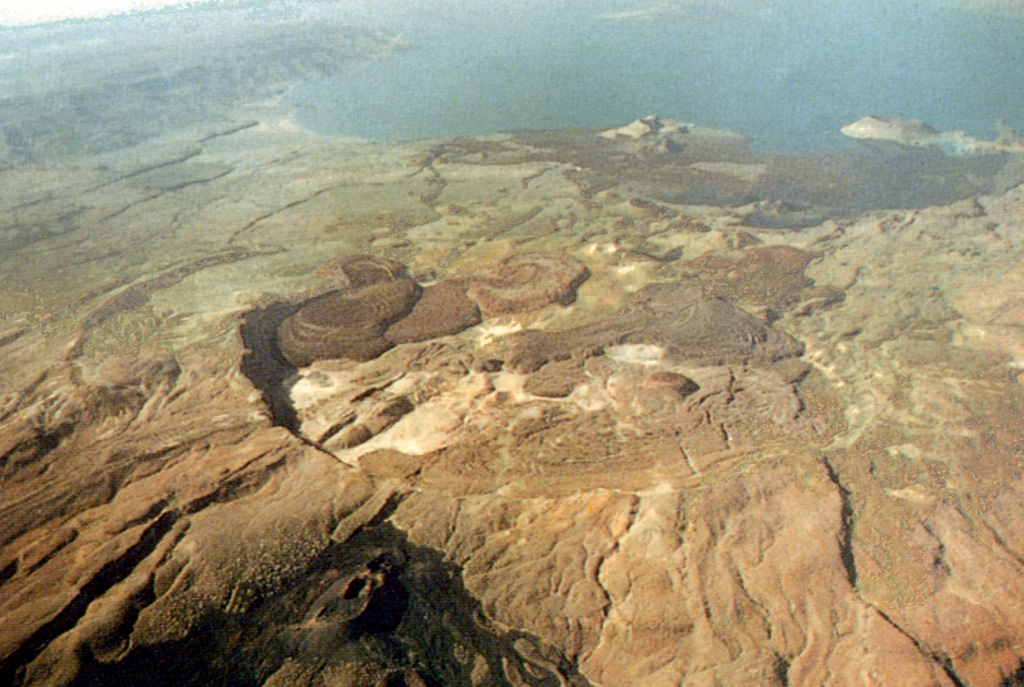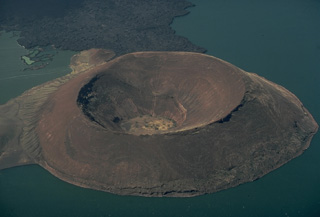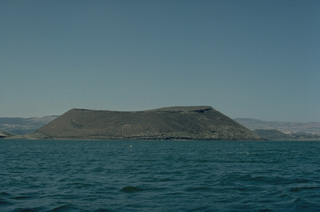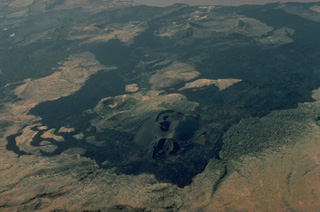

The Global Volcanism Program has no activity reports for The Barrier.
The Global Volcanism Program has no Weekly Reports available for The Barrier.
The Global Volcanism Program has no Bulletin Reports available for The Barrier.
This compilation of synonyms and subsidiary features may not be comprehensive. Features are organized into four major categories: Cones, Craters, Domes, and Thermal Features. Synonyms of features appear indented below the primary name. In some cases additional feature type, elevation, or location details are provided.
Synonyms |
||||
| Sil | Nagaramasaina | ||||
Cones |
||||
| Feature Name | Feature Type | Elevation | Latitude | Longitude |
|
Andrew's Cone
Likayu Lugugugut Sugobo |
Stratovolcano | 915 m | 2° 20' 0" N | 36° 33' 0" E |
| Kakorinya | Shield volcano | 1030 m | 2° 19' 0" N | 36° 34' 0" E |
| Kalolenyang | Shield volcano | 1128 m | 2° 19' 0" N | 36° 31' 0" E |
| Likaiu East | Shield volcano | |||
| Likaiu West | Shield volcano | |||
| Murniau | Tuff cone | |||
|
Nabuyatom
Naboiyoton |
Tuff cone | 582 m | 2° 26' 0" N | 36° 38' 0" E |
| Nagira Mwaiten | Cone | |||
| Namurinyang | Tuff cone | 735 m | 2° 15' 0" N | 36° 38' 0" E |
|
Naperito
Cathedral Rock |
Tuff cone | 414 m | 2° 13' 0" N | 36° 35' 0" E |
| Teleki's Cone | Cone | 646 m | 2° 22' 0" N | 36° 36' 0" E |
|
Wargess
Abili Agituk |
Tuff cone | 573 m | 2° 26' 0" N | 36° 36' 0" E |
Thermal |
||||
| Feature Name | Feature Type | Elevation | Latitude | Longitude |
| Logkipi Geyser | Geyser | |||
|
Suguta-Logkipi
Saguta Swamp Sukuta See Engare Sukuta Lokippi |
Thermal | 425 m | 2° 15' 0" N | 36° 35' 0" E |
|
|
||||||||||||||||||||||||
There is data available for 10 confirmed Holocene eruptive periods.
1921 Dec 31 ± 365 days Confirmed Eruption Max VEI: 2
| Episode 1 | Eruption Episode | North flank (Teleki) | ||||||||||||||||||||||||
|---|---|---|---|---|---|---|---|---|---|---|---|---|---|---|---|---|---|---|---|---|---|---|---|---|---|
| 1921 Dec 31 ± 365 days - Unknown | Evidence from Observations: Reported | ||||||||||||||||||||||||
|
List of 3 Events for Episode 1 at North flank (Teleki)
| |||||||||||||||||||||||||
[ 1920 ± 3 years ] Uncertain Eruption
| Episode 1 | Eruption Episode | South flank (Andrew's Volcano) | ||||||||||||||
|---|---|---|---|---|---|---|---|---|---|---|---|---|---|---|---|
| 1920 ± 3 years - Unknown | Evidence from Unknown | ||||||||||||||
|
List of 1 Events for Episode 1 at South flank (Andrew's Volcano)
| |||||||||||||||
1917 Confirmed Eruption Max VEI: 2
| Episode 1 | Eruption Episode | Andrew's or Teleki's Volcanoes | |||||||||||||||||||
|---|---|---|---|---|---|---|---|---|---|---|---|---|---|---|---|---|---|---|---|---|
| 1917 - Unknown | Evidence from Observations: Reported | |||||||||||||||||||
|
List of 2 Events for Episode 1 at Andrew's or Teleki's Volcanoes
| ||||||||||||||||||||
[ 1906 ] Uncertain Eruption
| Episode 1 | Eruption Episode | Andrew's or Teleki's Cones | ||||||||||||||
|---|---|---|---|---|---|---|---|---|---|---|---|---|---|---|---|
| 1906 - Unknown | Evidence from Unknown | ||||||||||||||
|
List of 1 Events for Episode 1 at Andrew's or Teleki's Cones
| |||||||||||||||
1897 May (in or before) Confirmed Eruption Max VEI: 2 (?)
| Episode 1 | Eruption Episode | North flank (Teleki) and Likaiu | |||||||||||||||||||||||||||||
|---|---|---|---|---|---|---|---|---|---|---|---|---|---|---|---|---|---|---|---|---|---|---|---|---|---|---|---|---|---|---|
| 1897 May (in or before) - Unknown | Evidence from Observations: Reported | |||||||||||||||||||||||||||||
|
List of 4 Events for Episode 1 at North flank (Teleki) and Likaiu
| ||||||||||||||||||||||||||||||
1895 Confirmed Eruption Max VEI: 2
| Episode 1 | Eruption Episode | North flank (Teleki's Cone) | ||||||||||||||||||||||||
|---|---|---|---|---|---|---|---|---|---|---|---|---|---|---|---|---|---|---|---|---|---|---|---|---|---|
| 1895 - Unknown | Evidence from Observations: Reported | ||||||||||||||||||||||||
|
List of 3 Events for Episode 1 at North flank (Teleki's Cone)
| |||||||||||||||||||||||||
1888 Confirmed Eruption Max VEI: 0
| Episode 1 | Eruption Episode | North flank (Teleki's Cone) | |||||||||||||||||||
|---|---|---|---|---|---|---|---|---|---|---|---|---|---|---|---|---|---|---|---|---|
| 1888 - Unknown | Evidence from Observations: Reported | |||||||||||||||||||
|
List of 2 Events for Episode 1 at North flank (Teleki's Cone)
| ||||||||||||||||||||
1871 ± 3 years Confirmed Eruption Max VEI: 2
| Episode 1 | Eruption Episode | North flank (Teleki's Cone) | ||||||||||||||||||||||||
|---|---|---|---|---|---|---|---|---|---|---|---|---|---|---|---|---|---|---|---|---|---|---|---|---|---|
| 1871 ± 3 years - Unknown | Evidence from Observations: Reported | ||||||||||||||||||||||||
|
List of 3 Events for Episode 1 at North flank (Teleki's Cone)
| |||||||||||||||||||||||||
1090 ± 50 years Confirmed Eruption Max VEI: 0
| Episode 1 | Eruption Episode | North flank | |||||||||||||||||||
|---|---|---|---|---|---|---|---|---|---|---|---|---|---|---|---|---|---|---|---|---|
| 1090 ± 50 years - Unknown | Evidence from Correlation: Magnetism | |||||||||||||||||||
|
List of 2 Events for Episode 1 at North flank
| ||||||||||||||||||||
1050 ± 150 years Confirmed Eruption Max VEI: 0
| Episode 1 | Eruption Episode | North flank | |||||||||||||||||||
|---|---|---|---|---|---|---|---|---|---|---|---|---|---|---|---|---|---|---|---|---|
| 1050 ± 150 years - Unknown | Evidence from Correlation: Magnetism | |||||||||||||||||||
|
List of 2 Events for Episode 1 at North flank
| ||||||||||||||||||||
1030 ± 150 years Confirmed Eruption Max VEI: 0
| Episode 1 | Eruption Episode | North flank | |||||||||||||||||||
|---|---|---|---|---|---|---|---|---|---|---|---|---|---|---|---|---|---|---|---|---|
| 1030 ± 150 years - Unknown | Evidence from Correlation: Magnetism | |||||||||||||||||||
|
List of 2 Events for Episode 1 at North flank
| ||||||||||||||||||||
7710 BCE ± 200 years Confirmed Eruption
| Episode 1 | Eruption Episode | North (Abili Agituk) and south flanks | |||||||||||||||||||
|---|---|---|---|---|---|---|---|---|---|---|---|---|---|---|---|---|---|---|---|---|
| 7710 BCE ± 200 years - Unknown | Evidence from Correlation: Tephrochronology | |||||||||||||||||||
|
List of 2 Events for Episode 1 at North (Abili Agituk) and south flanks
| ||||||||||||||||||||
There is no Deformation History data available for The Barrier.
There is no Emissions History data available for The Barrier.
 The pristine Naboiyoton tuff cone rises above Lake Turkana in northern Kenya. The tuff cone, seen here from the north, is a satellitic cone on the north flank of The Barrier volcano. It rises 180 m above the lake, and was formed by explosive eruptions produced when magma rising up along the East African Rift encountered the waters of Lake Turkana. The age of the tuff cone is not known, but its lower slopes lack erosional terraces created during higher stands of the lake. The lava flow at the top was erupted from The Barrier volcano.
The pristine Naboiyoton tuff cone rises above Lake Turkana in northern Kenya. The tuff cone, seen here from the north, is a satellitic cone on the north flank of The Barrier volcano. It rises 180 m above the lake, and was formed by explosive eruptions produced when magma rising up along the East African Rift encountered the waters of Lake Turkana. The age of the tuff cone is not known, but its lower slopes lack erosional terraces created during higher stands of the lake. The lava flow at the top was erupted from The Barrier volcano. Naboiyoton tuff cone is seen here across Lake Turkana from the NE with The Barrier shield volcano in the background. The steep slopes and wide crater of the tuff cone produce a flat-topped profile, which is typical of tuff cones. This results from powerful phreatomagmatic eruptions produced by the interaction of magma and water. The Barrier volcano draws its name from its prominent topographic position astride the East African Rift between Lake Turkana and the Sukota Trough to the south.
Naboiyoton tuff cone is seen here across Lake Turkana from the NE with The Barrier shield volcano in the background. The steep slopes and wide crater of the tuff cone produce a flat-topped profile, which is typical of tuff cones. This results from powerful phreatomagmatic eruptions produced by the interaction of magma and water. The Barrier volcano draws its name from its prominent topographic position astride the East African Rift between Lake Turkana and the Sukota Trough to the south. The Barrier volcano separates Lake Turkana from the Suguta Trough to the south, the site of a former lake. The volcano is comprised of four overlapping shield volcanoes. This view looks down the north flank of the volcano with Lake Turkana at the upper right. Holocene fissure-related scoria cones and lava flows, including the historically active Teleki's and Andrew's cones (lower center), dot the volcano's southern and northern flanks. Historical eruptions have produced explosive activity and lava flows during the 19th and 20th centuries.
The Barrier volcano separates Lake Turkana from the Suguta Trough to the south, the site of a former lake. The volcano is comprised of four overlapping shield volcanoes. This view looks down the north flank of the volcano with Lake Turkana at the upper right. Holocene fissure-related scoria cones and lava flows, including the historically active Teleki's and Andrew's cones (lower center), dot the volcano's southern and northern flanks. Historical eruptions have produced explosive activity and lava flows during the 19th and 20th centuries. A northward-looking aerial view shows the summit caldera of Kakorinya volcano of The Barrier volcanic complex with Lake Turkana in the distance. The 3.8-km-wide summit caldera was formed about 92,000 years ago, and post-caldera lava domes and flows fill much of the caldera floor. Fresh-looking lava flows and tuff cones occur along the shores of Lake Turkana. Teleki's Cone on the northern flank and Andrew's Cone (lower left foreground) on the southern flank have been the source of historical lava flows.
A northward-looking aerial view shows the summit caldera of Kakorinya volcano of The Barrier volcanic complex with Lake Turkana in the distance. The 3.8-km-wide summit caldera was formed about 92,000 years ago, and post-caldera lava domes and flows fill much of the caldera floor. Fresh-looking lava flows and tuff cones occur along the shores of Lake Turkana. Teleki's Cone on the northern flank and Andrew's Cone (lower left foreground) on the southern flank have been the source of historical lava flows.The maps shown below have been scanned from the GVP map archives and include the volcano on this page. Clicking on the small images will load the full 300 dpi map. Very small-scale maps (such as world maps) are not included. The maps database originated over 30 years ago, but was only recently updated and connected to our main database. We welcome users to tell us if they see incorrect information or other problems with the maps; please use the Contact GVP link at the bottom of the page to send us email.
There are no samples for The Barrier in the Smithsonian's NMNH Department of Mineral Sciences Rock and Ore collection.
| Copernicus Browser | The Copernicus Browser replaced the Sentinel Hub Playground browser in 2023, to provide access to Earth observation archives from the Copernicus Data Space Ecosystem, the main distribution platform for data from the EU Copernicus missions. |
| MIROVA | Middle InfraRed Observation of Volcanic Activity (MIROVA) is a near real time volcanic hot-spot detection system based on the analysis of MODIS (Moderate Resolution Imaging Spectroradiometer) data. In particular, MIROVA uses the Middle InfraRed Radiation (MIR), measured over target volcanoes, in order to detect, locate and measure the heat radiation sourced from volcanic activity. |
| MODVOLC Thermal Alerts | Using infrared satellite Moderate Resolution Imaging Spectroradiometer (MODIS) data, scientists at the Hawai'i Institute of Geophysics and Planetology, University of Hawai'i, developed an automated system called MODVOLC to map thermal hot-spots in near real time. For each MODIS image, the algorithm automatically scans each 1 km pixel within it to check for high-temperature hot-spots. When one is found the date, time, location, and intensity are recorded. MODIS looks at every square km of the Earth every 48 hours, once during the day and once during the night, and the presence of two MODIS sensors in space allows at least four hot-spot observations every two days. Each day updated global maps are compiled to display the locations of all hot spots detected in the previous 24 hours. There is a drop-down list with volcano names which allow users to 'zoom-in' and examine the distribution of hot-spots at a variety of spatial scales. |
|
WOVOdat
Single Volcano View Temporal Evolution of Unrest Side by Side Volcanoes |
WOVOdat is a database of volcanic unrest; instrumentally and visually recorded changes in seismicity, ground deformation, gas emission, and other parameters from their normal baselines. It is sponsored by the World Organization of Volcano Observatories (WOVO) and presently hosted at the Earth Observatory of Singapore.
GVMID Data on Volcano Monitoring Infrastructure The Global Volcano Monitoring Infrastructure Database GVMID, is aimed at documenting and improving capabilities of volcano monitoring from the ground and space. GVMID should provide a snapshot and baseline view of the techniques and instrumentation that are in place at various volcanoes, which can be use by volcano observatories as reference to setup new monitoring system or improving networks at a specific volcano. These data will allow identification of what monitoring gaps exist, which can be then targeted by remote sensing infrastructure and future instrument deployments. |
| Volcanic Hazard Maps | The IAVCEI Commission on Volcanic Hazards and Risk has a Volcanic Hazard Maps database designed to serve as a resource for hazard mappers (or other interested parties) to explore how common issues in hazard map development have been addressed at different volcanoes, in different countries, for different hazards, and for different intended audiences. In addition to the comprehensive, searchable Volcanic Hazard Maps Database, this website contains information about diversity of volcanic hazard maps, illustrated using examples from the database. This site is for educational purposes related to volcanic hazard maps. Hazard maps found on this website should not be used for emergency purposes. For the most recent, official hazard map for a particular volcano, please seek out the proper institutional authorities on the matter. |
| IRIS seismic stations/networks | Incorporated Research Institutions for Seismology (IRIS) Data Services map showing the location of seismic stations from all available networks (permanent or temporary) within a radius of 0.18° (about 20 km at mid-latitudes) from the given location of The Barrier. Users can customize a variety of filters and options in the left panel. Note that if there are no stations are known the map will default to show the entire world with a "No data matched request" error notice. |
| UNAVCO GPS/GNSS stations | Geodetic Data Services map from UNAVCO showing the location of GPS/GNSS stations from all available networks (permanent or temporary) within a radius of 20 km from the given location of The Barrier. Users can customize the data search based on station or network names, location, and time window. Requires Adobe Flash Player. |
| DECADE Data | The DECADE portal, still in the developmental stage, serves as an example of the proposed interoperability between The Smithsonian Institution's Global Volcanism Program, the Mapping Gas Emissions (MaGa) Database, and the EarthChem Geochemical Portal. The Deep Earth Carbon Degassing (DECADE) initiative seeks to use new and established technologies to determine accurate global fluxes of volcanic CO2 to the atmosphere, but installing CO2 monitoring networks on 20 of the world's 150 most actively degassing volcanoes. The group uses related laboratory-based studies (direct gas sampling and analysis, melt inclusions) to provide new data for direct degassing of deep earth carbon to the atmosphere. |
| Large Eruptions of The Barrier | Information about large Quaternary eruptions (VEI >= 4) is cataloged in the Large Magnitude Explosive Volcanic Eruptions (LaMEVE) database of the Volcano Global Risk Identification and Analysis Project (VOGRIPA). |
| EarthChem | EarthChem develops and maintains databases, software, and services that support the preservation, discovery, access and analysis of geochemical data, and facilitate their integration with the broad array of other available earth science parameters. EarthChem is operated by a joint team of disciplinary scientists, data scientists, data managers and information technology developers who are part of the NSF-funded data facility Integrated Earth Data Applications (IEDA). IEDA is a collaborative effort of EarthChem and the Marine Geoscience Data System (MGDS). |